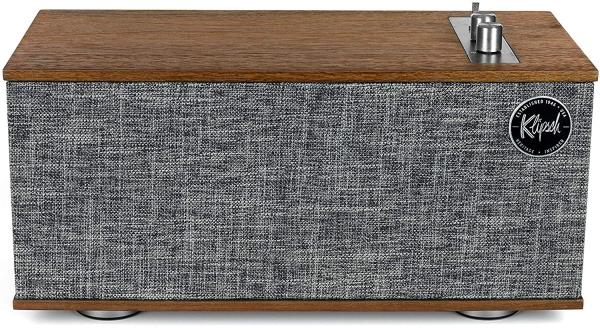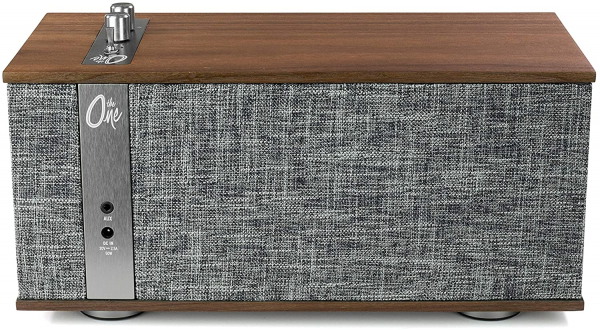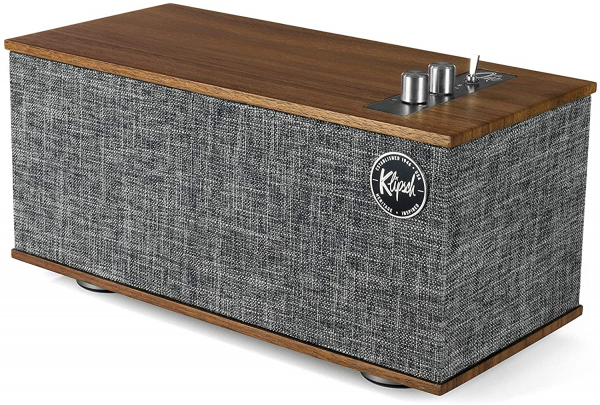Klipsch
Klipsch The One: the big transportable sound
Aprox. 359€
See specificationsThe smallest model in Klipsch's Heritage Wireless range of speakers, The One is also the simplest representative. Devoid of multiroom features, unlike its sister The Three, this speaker on the other hand has a battery that gives it the possibility of being used "really" wirelessly. This earned it the qualifier of transportable enclosure, despite the unusual dimensions for this category of products. But what do you want, when you're rock & roll like Klipsch, you like big sound. In every sense of the term.
Positive points
Lots of power and energy.
Distortion well controlled, made clean and precise.
Spacious, little directive emission.
Design and manufacturing.
Bad points
Sound may be too aggressive for certain tastes.
Very light connection.
No remote control in Bluetooth (navigation, volume unification).
Some quirks with the Bluetooth connection to iOS devices.
Our review
Ergonomics
Do you remember what we said about the design of the Klipsch The Three multiroom speaker? You can generally apply them almost to the letter to the Klipsch The One. Regarding its plastic, this speaker is a near-perfect clone of its big sister - or rather, a homothety: the same in smaller. Not that it suddenly stands out for its compactness; with its dimensions of 32.2 x 15.6 x 13.3 cm and almost 4 kg on the scale, it is probably one of the largest transportable speakers we have encountered.
Apart from that, we can only reiterate here all the compliments that we had addressed to the Three for its design. The lines are still as elegant, the materials (wood and aluminum) still as classy and the assembly still as satisfactory ... despite the lack of centering of the rotary control buttons, also duplicated identically!
Only Bluetooth compatible and not multiroom, the One also does the bare minimum in terms of wired connection: an analog auxiliary input on 3.5 mm mini-jack, and that's it. It's disappointing. In such a large volume, it was probably not very difficult to offer a little more choice.
Bluetooth connectivity side, we also regret to see that the One completely ignores the AVRCP profile (remote control). This means that no navigation command is present on the speaker: no skipping to the next / previous track or even a play / pause button. In addition, the volume control cannot be unified between the speaker and the source; it will therefore be necessary in all circumstances to juggle between the two. Forget also, of course, all the slightly advanced Bluetooth functionalities: no hands-free kit, no connection to several sources simultaneously ...
With a volume set at around 70% of its maximum value - that is to say already very high -, we measured an autonomy of around 7 hours - compared to the 8 hours promised by the technical sheet. By reducing this volume in half, we have however obtained ... double, or 14 hours of use on a charge. It is very respectable. Note in passing that when the enclosure turns off, only a long press has the effect of completely cutting off the power. A short press simply puts the speaker on standby, which is indicated by a slow and weak flashing of the power indicator. The speaker then remains capable of establishing Bluetooth communication, and of turning on automatically as soon as it receives a signal; but beware of discharging the battery during this time.

Audio
Do you remember what we said about the sound performance of the Klipsch The Three? Well ... you can generally apply them to the One too.
It turns out that the twinning between the two speakers does not stop at aesthetic considerations. From the Three, we thus find here a frequency response which gives pride of place to the extremes of the spectrum, so that we could speak of a sound signature in "U". The reinforcement of the treble is practically unchanged, with the consequence that the sound is always very piercing and surgical - even aggressive on the densest mixes. On the other hand, the emphasis on the bass, although still present, is significantly less pronounced; an unsurprising consequence of the smaller size of the One.
But the feeling in the ear is always the same: that of an extremely lively and dynamic sound, not always of the greatest subtlety, but controlled and of a very communicative energy. We just lost a few decibels of available power ... but the maximum volume remains colossal, generous enough to follow about all situations that we can reasonably imagine - including the sound of a very evening noisy.
There are also few differences when it comes to stereophony, which is always appreciable without being impressive. If the sound spatialization is not defined with great precision, the feeling of space is however very good, thanks to the clever positioning of the passive radiators on the sides of the enclosure rather than at the rear. This same trick also allows the emission cone to be entirely commendable in width.
As we said in the ergonomics section, the Klipsch The One is not compatible with the AVRCP Bluetooth profile, which has the consequence that the volume controls on the speaker and on the source cannot to be unified. In these circumstances, we usually say that it is better to leave the volume at the bottom on the source and adjust the listening level on the speaker only, this in order to preserve the signal quality as much as possible. This remains true on the Klipsch The One ... except for users of iOS devices: for a reason that is perfectly mysterious to us, on certain songs containing a little heavy percussion, the speaker generates a very annoying saturation as soon as it is connected to an iPhone or iPad whose volume is adjusted a little too loud. To avoid this phenomenon, it is necessary not to adjust the volume of the source device beyond about 60%. The speaker then becomes usable again, but obviously lost part of its power reserve in the process. Nothing dramatic, the latter remains quite generous - but it's still a little frustrating.
And this is not the only technical quirk that we encountered with the One: the other concerns latency in Bluetooth. Depending on the transmitter we use to perform the measurement, we get drastically different results.
One of these measures indicates a latency of 43 ms: it is simply exceptionally low. This figure is even within the range of values considered acceptable by the standards for cinema projection and television broadcasting; there would therefore, for once, be no use in compensating for the lag when watching a video!
Besides that, the measurement with another transmitter gives us an offset of 240 ms. A value much less impressive, and which would not allow, this time, to watch a video comfortably.
We suspect that these variations in measurements are due to differences in speaker behavior depending on the codec or Bluetooth profile used by the source, but unfortunately we are unable to verify these assumptions. So we can just tell you that in real use, alas, we hardly noticed that behaviors that seemed rather in phase with the second measure than with the first; a noticeable audio / video lag therefore.

Conclusion
Few surprises with this Klipsch The One. It simply turns out to be a slightly reduced Three and swaps its multiroom compatibility for a built-in battery. She shares with her big sister not only her very classy design, but also her sonic personality. Those who know how to put up with its high-pitched treble will therefore be able to take advantage of its inexhaustible energy. Too bad, however, that the wired connection is also minimalist. Beware also of the little quirks encountered when using iOS devices, not unacceptable, but still a little frustrating.
Specifications

